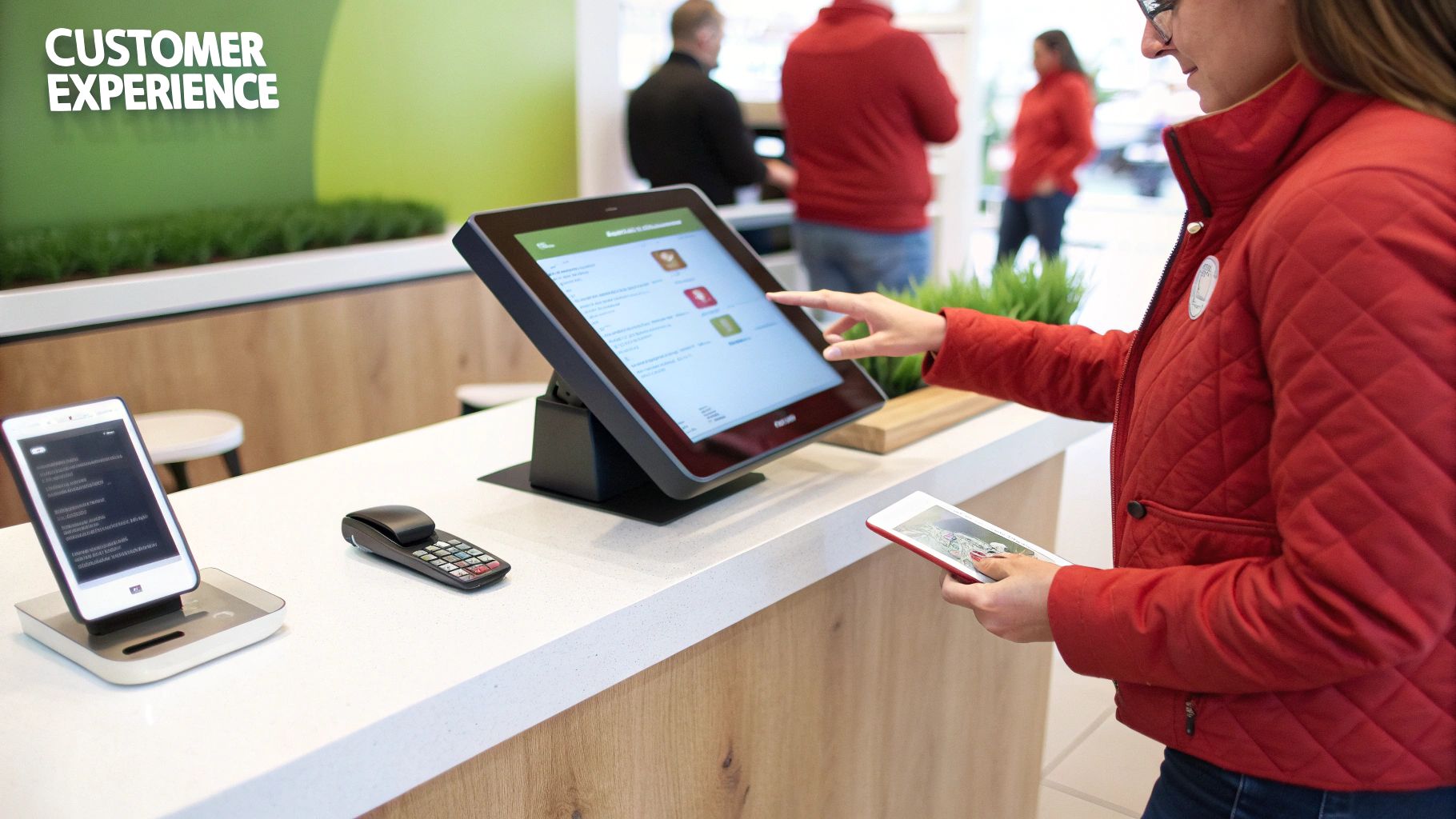Level Up Your Brand in 2025
A strong brand is essential for business success. This listicle provides seven proven brand building strategies to help your organization thrive. Learn how to leverage brand storytelling, consistent visuals, exceptional customer experiences, and content marketing excellence. We'll also explore purpose-driven branding, strategic partnerships, and employee advocacy to solidify your brand identity and achieve sustainable growth. These brand building strategies are crucial for attracting customers, building loyalty, and setting your business apart in a competitive market.
1. Brand Storytelling
Brand storytelling is a crucial brand building strategy that involves communicating your brand's history, values, and mission through compelling narratives. Instead of directly promoting products or services, it focuses on creating an emotional connection with your audience by sharing relatable and memorable stories. This approach humanizes your brand, fostering deeper customer loyalty and advocacy. By building these emotional connections, brand storytelling helps differentiate your company in crowded markets and strengthens brand recall. This strategy proves invaluable for establishing a powerful brand identity that resonates with consumers on a deeper level, moving beyond transactional interactions towards meaningful relationships.

This approach utilizes narrative-driven communication to evoke emotional responses and build lasting brand associations. Think of Nike's "Just Do It" campaign. It isn't just about selling shoes; it's about the inspiring stories of athletic perseverance that resonate with their target audience. Similarly, Airbnb's "Belong Anywhere" narrative taps into the universal desire for connection and community, fostering a sense of belonging among its users. These narratives, combined with consistent messaging across various channels, contribute significantly to brand building.
Examples of Successful Implementation:
- Nike: "Just Do It" campaign featuring stories of overcoming challenges and achieving athletic goals.
- Airbnb: "Belong Anywhere" narrative focusing on human connection and the feeling of home, wherever you are.
- Patagonia: Environmental activism stories through their "Worn Wear" program, emphasizing sustainability and responsible consumption.
- Apple: The origin story of Steve Jobs and Steve Wozniak starting the company in a garage, highlighting innovation and entrepreneurial spirit.
Actionable Tips for Brand Storytelling:
- Identify Core Values: Define your brand's core values and mission. Your story should authentically reflect these principles.
- Authenticity over Fabrication: Focus on genuine stories. Fabricated narratives can easily be perceived as inauthentic, damaging your brand's credibility.
- Multi-Format Storytelling: Utilize various formats like videos, social media posts, blog articles, and podcasts to share your story across different touchpoints.
- Customer Inclusion: Encourage customers to share their experiences with your brand, making them part of your ongoing narrative.
- Maintain Consistency: Ensure consistent messaging and storytelling across all communication channels for a cohesive brand experience.
Pros & Cons of Brand Storytelling:
Pros:
- Builds Emotional Connections: Creates stronger bonds with customers, leading to increased loyalty.
- Increases Brand Recall and Recognition: Memorable stories help customers remember and recognize your brand.
- Differentiates Brand in Crowded Markets: A unique narrative sets your brand apart from competitors.
- Facilitates Consistent Messaging: Provides a framework for cohesive communication across all channels.
Cons:
- Requires Creative Talent: Developing compelling narratives requires skilled storytellers.
- Time Investment: Building authentic stories can take time and effort.
- Consistency is Key: Brand actions must align with the story to avoid perceived inauthenticity.
- ROI Measurement: The return on investment of brand storytelling can be challenging to quantify directly.
Why Brand Storytelling Deserves Its Place in the List:
In today's competitive landscape, customers are seeking more than just products or services; they're seeking connection and meaning. Brand storytelling offers a powerful way to forge these connections, building a loyal customer base and fostering long-term brand growth. It is a fundamental element of successful brand building strategies, especially for Fortune 100 companies, tech startups, corporate marketing teams, venture capital firms, and event coordinators who need to resonate deeply with their target audience. The strategy’s ability to create emotional connections, differentiate the brand, and increase recall make it an essential component for any organization looking to build a strong and lasting brand presence. Influenced by thought leaders like Seth Godin and exemplified by successful campaigns like Coca-Cola's "Share a Coke," brand storytelling offers a proven framework for crafting narratives that resonate and drive results.
2. Consistent Visual Identity
A consistent visual identity is a cornerstone of effective brand building strategies. It involves meticulously crafting and maintaining a unified visual language across all brand touchpoints. This encompasses everything from your logo and color palette to typography, imagery style, and other design elements. The goal is to create a cohesive and instantly recognizable visual presence that resonates with your target audience and sets you apart in the marketplace. A strong visual identity ensures that every interaction a customer has with your brand, whether on your website, social media, or physical products, reinforces the same core message and values.

This strategy is particularly crucial for Fortune 100 companies, tech startups, corporate marketing teams, venture capital firms, and even event coordinators. For established corporations, a consistent visual identity helps maintain a unified brand image across diverse product lines and geographical markets. For startups seeking to establish themselves, it's essential for building brand recognition and cutting through the noise. Venture capital firms benefit by ensuring their portfolio companies project a professional and cohesive image. And for event coordinators, a consistent visual theme can significantly elevate the attendee experience.
A consistent visual identity strategy features a unified visual language across all platforms, comprehensive brand guidelines that dictate usage, distinctive and recognizable design elements, and—critically—consistent application of these elements across all touchpoints. This provides a seamless and cohesive brand experience for customers no matter how they interact with your brand.
Pros:
- Increased Brand Recognition and Recall: A consistent visual language makes your brand instantly recognizable, improving recall and strengthening its presence in the market.
- Builds Trust and Credibility: Professionalism and consistency conveyed through visuals build trust with your audience, signaling reliability and quality.
- Cohesive Brand Experience: Consistency across platforms creates a seamless and positive experience for customers, reinforcing brand loyalty.
- Visual Differentiation: A strong visual identity helps you stand out from competitors, carving a unique space in the market.
Cons:
- Implementation Costs: Developing and implementing a consistent visual identity across all materials can be initially expensive.
- Ongoing Management: Maintaining consistency requires ongoing vigilance and management, including regular audits.
- Periodic Refreshing: Visual identities may need updating over time, requiring careful execution to avoid losing brand recognition.
- Creative Constraints: Strict adherence to brand guidelines can sometimes limit creative flexibility in marketing campaigns.
Examples of Successful Implementation:
- Coca-Cola: The consistent use of the iconic script logo and red color palette has made Coca-Cola instantly recognizable globally for over a century.
- McDonald's: The golden arches and red/yellow color scheme are synonymous with fast food worldwide.
- Apple: Apple's minimalist design and consistent product aesthetics have cultivated a devoted following and a premium brand image.
- Tiffany & Co.: The proprietary robin's egg blue color is instantly associated with luxury and the Tiffany brand.
Actionable Tips:
- Develop Comprehensive Brand Style Guides: Detailed guidelines ensure everyone involved in representing your brand understands the rules of visual communication.
- Train All Team Members: Ensure all employees understand and adhere to the brand guidelines.
- Regular Audits: Conduct regular audits of all visual materials to ensure consistency and identify areas needing correction.
- Create Templates: Develop templates for common marketing materials to streamline the creation process and maintain consistency.
- Gradual Evolution: When updating your visual identity, opt for a gradual evolution rather than drastic changes to preserve brand recognition.
Consistent visual identity deserves a prominent place in any brand building strategy as it is fundamental to creating a strong and recognizable brand. By investing in a well-defined and consistently applied visual language, organizations can significantly enhance brand awareness, build trust with their target audience, and ultimately drive business growth. The work of design pioneers like Paul Rand (IBM, UPS, ABC logos) and Massimo Vignelli (NYC subway map, American Airlines logo) and agencies like Pentagram and Landor Associates, highlights the transformative power of a well-executed visual identity.
3. Customer Experience (CX) Strategy
A robust Customer Experience (CX) strategy is crucial for any brand aiming to build lasting relationships and differentiate itself in a competitive market. This brand-building strategy focuses on optimizing every interaction a customer has with your brand, spanning all touchpoints throughout the entire customer journey – from initial awareness to becoming a loyal advocate. This holistic approach aims to create consistently positive and memorable experiences that foster loyalty, encourage advocacy, and differentiate your brand not just by what you offer, but by how customers feel when engaging with you. A well-executed CX strategy goes beyond simply meeting customer needs; it anticipates them and strives to exceed expectations, building strong emotional connections that translate to tangible business benefits. This is a cornerstone of effective brand building strategies.

Features of a Strong CX Strategy:
- End-to-End Customer Journey Mapping: Visualizing the customer's journey from initial contact to long-term engagement helps identify critical touchpoints and optimize the experience at each stage.
- Multi-Channel Consistency: Ensuring a seamless and consistent brand experience across all channels, including online, offline, and in-person interactions.
- Personalization Capabilities: Tailoring interactions and offerings based on individual customer preferences and behaviors to create a more relevant and engaging experience.
- Customer Feedback Integration: Actively soliciting and incorporating customer feedback to identify areas for improvement and enhance the overall CX.
- Continuous Improvement Processes: Regularly evaluating and refining the CX strategy based on data analysis and customer insights to ensure ongoing optimization.
Pros:
- Builds Strong Emotional Connections: Positive experiences create a sense of loyalty and affinity towards your brand.
- Reduces Churn and Increases Lifetime Value: Satisfied customers are more likely to stay with your brand and spend more over time.
- Creates Organic Brand Advocates and Word-of-Mouth Marketing: Exceptional CX drives positive word-of-mouth referrals and organic brand advocacy.
- Provides Competitive Advantage Beyond Product Features: In a crowded marketplace, CX can be a key differentiator, even if product features are similar.
- Often Leads to Premium Pricing Opportunities: Customers are willing to pay more for a superior experience.
Cons:
- Requires Significant Cross-Departmental Coordination: Implementing a successful CX strategy requires alignment and collaboration across various teams.
- Can be Resource-Intensive to Implement Fully: Developing and maintaining a comprehensive CX strategy can require significant investment in technology, training, and personnel.
- Demands Consistent Execution Across All Touchpoints: Consistency is key to delivering a seamless and positive CX. Lapses in any area can damage the overall perception of the brand.
- Takes Time to Show ROI in Financial Metrics: While the benefits of a strong CX are substantial, the return on investment may not be immediately apparent.
Examples of Successful CX Implementation:
- Disney: Immersive theme park experiences and meticulous attention to detail create a magical and memorable customer journey.
- Amazon: One-click purchasing, hassle-free returns, and a customer-centric philosophy have made Amazon a leader in online retail.
- Zappos: Legendary customer service, empowered employees, and a focus on building personal connections are hallmarks of Zappos' CX strategy.
- Ritz-Carlton: Empowering employees to resolve customer issues on the spot creates a sense of trust and reinforces the brand's commitment to exceptional service.
- Starbucks: Personalized mobile ordering and rewards programs enhance convenience and foster customer loyalty.
Tips for Implementing a CX Strategy:
- Map Your Entire Customer Journey: Identify all touchpoints and understand the customer experience at each stage.
- Identify and Eliminate Pain Points: Address any friction or frustration in the customer journey.
- Train Every Employee to Understand Their Role in CX Delivery: Every employee, regardless of their department, should understand their impact on the customer experience.
- Implement Systematic Customer Feedback Collection: Regularly solicit feedback through surveys, reviews, and social media monitoring.
- Create Consistent Experiences Across Digital and Physical Touchpoints: Ensure a seamless and integrated experience across all channels.
- Measure CX with Metrics like Net Promoter Score (NPS) and Customer Effort Score (CES): Track and analyze key metrics to assess the effectiveness of your CX strategy.
Why CX Deserves Its Place in Brand Building Strategies:
In today's competitive landscape, a strong CX strategy is no longer a luxury but a necessity. It's a critical component of brand building because it directly influences customer perception, loyalty, and advocacy. For Fortune 100 companies, tech startups, and corporate marketing teams alike, investing in CX can lead to increased customer lifetime value, reduced churn, and a stronger brand reputation. Venture capital firms recognize the importance of CX in evaluating investment opportunities, and event coordinators can leverage CX principles to create more engaging and memorable experiences.
This strategy is popularized by thought leaders like Tony Hsieh (former Zappos CEO), Jeff Bezos and Amazon’s customer obsession philosophy, and the authors of the “Experience Economy” concept. Industry analysts like Forrester Research and their CX Index also provide valuable insights and benchmarks. The Disney Institute offers training and consulting services based on Disney's renowned approach to customer experience. By prioritizing CX, businesses can build stronger brands, cultivate loyal customers, and drive sustainable growth.
4. Content Marketing Excellence
Content Marketing Excellence is a powerful brand-building strategy that focuses on creating and distributing valuable, relevant, and consistent content to attract and retain a clearly defined audience. Unlike traditional advertising, which directly pitches products or services, content marketing seeks to provide informative and engaging materials that empower potential customers. This approach positions your brand as a trusted authority and thought leader within your industry, fostering stronger relationships and ultimately driving profitable customer action.

This strategy leverages a value-first approach, prioritizing the audience's needs and interests above overt promotional messaging. By delivering insightful blog posts, engaging videos, informative podcasts, eye-catching infographics, and other forms of content, you can educate prospects, address their pain points, and guide them through the buyer's journey. This approach builds trust and credibility, making it more likely that they'll choose your brand when they're ready to purchase. Content Marketing Excellence deserves its place amongst top brand building strategies because it focuses on long-term relationship building and organic growth, leading to sustainable brand loyalty.
Features of Effective Content Marketing:
- Value-Driven Content: Focus on providing valuable information that solves customer problems.
- Diverse Content Formats: Utilize a variety of formats such as blogs, videos, podcasts, infographics, and white papers to cater to different audience preferences.
- SEO Optimization: Optimize your content for search engines to improve discoverability and organic reach.
- Strategic Distribution: Share your content strategically across multiple channels, including social media, email marketing, and industry publications.
- Buyer Journey Mapping: Tailor your content to different stages of the buyer’s journey, providing relevant information at each step.
Pros:
- Establishes Thought Leadership: Positions your brand as an expert in your industry.
- Drives Organic Traffic & Leads: Attracts potential customers through search engines and other online channels.
- Creates Long-Term Value: Evergreen content continues to generate leads and build brand awareness over time.
- Shortens Sales Cycles: Educated prospects are more likely to make quicker purchasing decisions.
- Cost-Effective: Content marketing is significantly more cost-effective than traditional marketing, generating 3x more leads while costing 62% less.
Cons:
- Resource Intensive: Requires ongoing content creation, which can be time-consuming and demanding.
- Slow Build: Results typically take time to materialize, requiring patience and consistency.
- Maintenance & Updates: Content needs regular updates to remain relevant and accurate.
- Competitive Landscape: Requires a strategic approach to stand out in a content-saturated world.
- Diverse Skill Sets: Demands expertise in writing, design, SEO, and other areas.
Examples of Successful Content Marketing:
- HubSpot: Their comprehensive marketing resources and blog have established them as a leading authority in inbound marketing.
- Red Bull: Their media house produces captivating extreme sports content, reinforcing their brand image and engaging a dedicated audience.
- American Express: Their OPEN Forum provides valuable resources for small businesses, strengthening their relationship with this key customer segment.
- Glossier: Built a thriving beauty community through their blog, Into The Gloss, driving significant brand awareness and loyalty.
- Blendtec: Their "Will It Blend?" video series went viral, showcasing their product's power in a fun and engaging way.
Actionable Tips for Content Marketing Excellence:
- Develop a Content Strategy: Align your content strategy with your overall business goals and target audience.
- Establish Content Pillars: Focus on key topic areas that reflect your expertise and resonate with your audience.
- Solve Customer Problems: Prioritize content that addresses customer pain points and provides valuable solutions.
- Repurpose Content: Maximize the reach and impact of your content by repurposing it across multiple formats.
- Data-Driven Optimization: Use data analytics to refine your content topics, distribution strategies, and overall approach.
- Balance Timely and Evergreen Content: Create a mix of content that addresses current trends and provides lasting value.
This approach is particularly valuable for Fortune 100 companies, tech startups, corporate marketing teams, venture capital firms, and event coordinators seeking to build strong brands and establish thought leadership. By providing valuable content that resonates with their target audiences, these organizations can foster stronger relationships, drive organic growth, and achieve long-term success. Learn more about Content Marketing Excellence
This strategy is ideal for building brand authority and generating organic leads over time, making it a crucial component of any comprehensive brand-building strategy. Content Marketing Excellence is not a quick fix; it’s a long-term investment that yields significant returns when executed strategically and consistently.
5. Purpose-Driven Branding
In today's increasingly conscious marketplace, purpose-driven branding has become a powerful brand building strategy, particularly for Fortune 100 companies, tech startups, and corporate marketing teams seeking to resonate with discerning consumers. This approach places a company's social mission or values at the very core of its brand identity, aligning business goals with positive social impact. It's a strategy that goes beyond simply generating profit; it addresses larger societal, environmental, or ethical issues, connecting with customers who prioritize brands reflecting their personal values. This resonates particularly well with Millennials and Gen Z, who are often driving purchasing decisions based on these factors.
Purpose-driven branding requires a clear articulation of a brand's purpose beyond profit. This involves integrating a social or environmental mission into the business model and demonstrating an authentic commitment to stated values through transparent practices and communications. This stakeholder-focused approach, rather than simply focusing on shareholders, builds deeper emotional connections with customers. It fosters a sense of shared values and creates a community around the brand.
Several features distinguish successful purpose-driven brands:
- Clear articulation of brand purpose beyond profit: The purpose should be easily understandable and resonate with the target audience.
- Social or environmental mission integration: The purpose must be woven into the fabric of the business, not just a marketing tactic.
- Authentic commitment to stated values: Consumers can spot inauthenticity quickly, so genuine commitment is crucial.
- Transparent practices and communications: Openly sharing information about the brand's actions and impact builds trust.
- Stakeholder (not just shareholder) focus: Considering the impact on employees, communities, and the environment alongside profitability.
Numerous examples demonstrate the effectiveness of purpose-driven branding:
- Patagonia: Known for its environmental activism and 1% for the Planet commitment, donating a percentage of sales to environmental organizations.
- TOMS: Built on the one-for-one giving model, donating a pair of shoes for every pair purchased.
- Ben & Jerry's: Famous for outspoken social justice advocacy, taking stances on issues like racial equality and climate change.
- Dove: The "Real Beauty" campaigns address body image issues and promote self-acceptance.
- Warby Parker: Employs a "Buy a Pair, Give a Pair" program, providing eyeglasses to those in need.
While purpose-driven branding offers significant advantages, it's essential to be aware of the potential drawbacks:
Pros:
- Resonates with value-conscious consumers, particularly Millennials and Gen Z
- Creates deeper emotional connections with customers
- Attracts and retains mission-aligned employees
- Differentiates in crowded marketplaces
- Can lead to customer advocacy and loyalty beyond typical brand relationships
Cons:
- Requires genuine commitment (greenwashing backfires severely)
- May alienate customers who disagree with the brand stance
- Purpose must align with the business model to be credible
- Demands consistent action across all business operations
- Success metrics can be challenging to define and measure
Tips for Implementing Purpose-Driven Branding:
- Identify an authentic purpose connected to your business model: The purpose should feel natural and not forced.
- Ensure leadership is genuinely committed to the purpose: Top-down support is crucial for successful implementation.
- Take meaningful action before promoting your purpose: Actions speak louder than words; demonstrate commitment through tangible initiatives.
- Measure and transparently report impact: Show stakeholders the positive difference the brand is making.
- Integrate purpose throughout the organization, not just marketing: Every department should embody the brand's purpose.
- Be prepared to defend your stance during controversies: Taking a stand can attract criticism, so be ready to address it constructively.
Purpose-driven branding deserves its place amongst top brand building strategies because it offers a path to building a brand that is not only profitable but also contributes positively to the world. It's a strategy that appeals to the growing segment of consumers who are seeking brands that align with their values. For venture capital firms and event coordinators looking to partner with companies demonstrating long-term viability and positive impact, purpose-driven brands are increasingly attractive. Learn more about Purpose-Driven Branding. This approach, popularized by figures like Patagonia founder Yvon Chouinard, TOMS founder Blake Mycoskie, and author Simon Sinek (Start With Why), as well as movements like the B Corporation movement, offers a compelling framework for long-term brand growth and societal impact.
6. Strategic Brand Partnerships
Strategic brand partnerships are a powerful brand building strategy that involves collaborating with complementary brands to achieve shared marketing objectives. By leveraging the strengths, audiences, and brand equity of both companies, these partnerships can create synergistic opportunities that neither brand could achieve alone. This approach is particularly effective for Fortune 100 companies, tech startups, corporate marketing teams, venture capital firms, and event coordinators looking to expand their reach, enhance brand perception, and drive innovative marketing initiatives.
This strategy works by identifying brands with aligned values and target audiences but distinct and complementary product or service offerings. Through joint marketing initiatives, co-branded products, or shared experiences, partners can tap into each other's established customer base, share resources and distribution channels, and generate significant buzz.
Features and Benefits of Strategic Brand Partnerships:
- Complementary Brand Alignment: Partnerships are most successful when both brands share similar values and target a similar demographic but offer distinct products or services.
- Shared Resources and Distribution Channels: Leveraging existing infrastructure and distribution networks allows for cost savings and broader market penetration.
- Co-created Offerings or Experiences: Developing unique co-branded products or experiences creates novelty and excitement for consumers.
- Combined Marketing Reach: Partners can significantly expand their reach by tapping into each other's established audience.
- Mutual Brand Equity Enhancement: Successful partnerships can enhance the perceived value and reputation of both brands.
Pros:
- Expanded Reach: Access a larger, pre-existing audience through the partner brand.
- Increased Buzz and Novelty: Unexpected collaborations generate excitement and media attention.
- Cost and Resource Sharing: Distribute marketing costs and leverage combined resources.
- Positive Brand Association Transfer: Benefit from the positive reputation and brand equity of the partner.
- New Market Entry: Gain access to new markets or customer segments through the partner's established presence.
Cons:
- Brand Dilution or Misalignment: A poorly chosen partnership can damage brand image and confuse customers.
- Complex Legal and Financial Arrangements: Negotiating and managing partnership agreements can be complex.
- Reputation Risk: Negative publicity surrounding a partner can impact your brand.
- Messaging Consistency Challenges: Maintaining consistent brand messaging across multiple platforms and audiences can be difficult.
- Partner Dependency: The success of the partnership relies on the performance and reliability of both parties.
Examples of Successful Strategic Brand Partnerships:
- Apple and Nike (Nike+): Integrating technology with athletic wear to enhance the running experience.
- Spotify and Uber: Providing a seamless in-car music experience.
- Doritos and Taco Bell (Doritos Locos Tacos): Creating a unique and highly successful co-branded product.
- Supreme and Louis Vuitton: Generating buzz and exclusivity through a high-fashion streetwear collaboration.
- GoPro and Red Bull (Stratos): Capturing a groundbreaking event and achieving massive global exposure.
Tips for Successful Brand Partnerships:
- Choose Partners Wisely: Select partners with shared values and complementary offerings that align with your target audience.
- Establish Clear Goals: Define specific, measurable objectives for the partnership.
- Detailed Agreements: Create comprehensive contracts that cover all operational aspects.
- Integrated Marketing Plans: Develop cohesive marketing strategies that benefit both brands.
- Start Small: Begin with limited-time collaborations before committing to long-term partnerships.
- Consistent Brand Experience: Ensure a seamless and consistent brand experience across all touchpoints.
When and Why to Use This Approach:
Strategic brand partnerships are particularly effective when you want to:
- Expand your reach to new customer segments.
- Generate buzz and excitement around your brand.
- Share marketing costs and resources.
- Enhance brand perception and credibility.
- Enter new markets or product categories.
Learn more about Strategic Brand Partnerships
Strategic brand partnerships deserve a prominent place in any list of brand building strategies because they offer a powerful way to leverage external resources and expertise to achieve significant growth and brand enhancement. By carefully selecting partners and developing well-defined strategies, businesses can unlock synergistic opportunities that drive innovation and market leadership. This approach is particularly relevant in today's competitive landscape, where collaboration and strategic alliances are increasingly crucial for success.
7. Employee Brand Advocacy: Turning Your Workforce into Brand Champions
Employee brand advocacy is a powerful brand building strategy that leverages the authentic voices of your employees to promote your company. It transforms your workforce into a network of credible brand ambassadors who share their positive experiences and perspectives through their own social media channels, personal networks, and daily interactions. This approach recognizes that in today's digital landscape, employee voices often carry more weight and trust than traditional corporate communications. For Fortune 100 companies, tech startups, corporate marketing teams, venture capital firms, and even event coordinators, understanding and implementing this strategy can be a game-changer in building a strong and reputable brand.
How Employee Brand Advocacy Works:
At its core, employee brand advocacy is about aligning your internal culture with your external brand promises. It involves empowering your employees to become authentic storytellers for your brand. This is achieved through:
- Internal Culture Alignment: Ensuring that the values and experiences within your company match the message you project to the outside world.
- Employee Training: Providing comprehensive training on brand messaging, values, and social media best practices.
- Amplification Tools and Guidelines: Equipping employees with the resources and support they need to share brand content effectively, while providing clear guidelines to maintain brand consistency.
- Recognition Programs: Acknowledging and rewarding employees who actively participate in brand advocacy efforts.
- Content Creation Support: Offering assistance and resources for employees to create engaging and shareable content.
Why Employee Advocacy Deserves a Place in Your Brand Building Strategy:
Employee brand advocacy earns its spot as a top brand building strategy because it delivers numerous benefits:
- Increased Trust and Credibility: Messages from employees are trusted 3x more than corporate communications, building stronger connections with potential customers.
- Extended Brand Reach: Leveraging employees' combined networks significantly expands your brand's visibility and reach.
- Authentic Content Creation: Empowering employees to share their unique perspectives creates diverse and engaging content that resonates with audiences.
- Improved Employee Engagement and Retention: Investing in employee advocacy fosters a sense of belonging and purpose, boosting morale and retention rates.
- Humanizing the Brand: Personal stories from employees add a human touch to your brand, making it more relatable and approachable.
Pros and Cons:
While the benefits are significant, it's crucial to understand the potential challenges:
Pros:
- Enhanced brand trust and credibility
- Expanded brand reach
- Authentic content creation
- Improved employee engagement and retention
- Humanized brand image
Cons:
- Requires strong internal culture and employee satisfaction
- Risk of off-message communications
- Needs ongoing management and program maintenance
- Success depends on voluntary participation
- Difficult to measure direct ROI
Successful Examples:
Many companies have successfully implemented employee brand advocacy programs:
- Adobe's #AdobeLife: Showcases employee experiences and company culture.
- Dell's Social Media and Communities University: Provides comprehensive training for employee advocates.
- Zappos: Empowers employees to share culture stories on social media.
- Starbucks: Leverages "partners" (employees) as brand ambassadors.
- IBM: Reaches millions through its sophisticated employee advocacy program.
Actionable Tips for Implementing Employee Brand Advocacy:
- Address Internal Culture: A positive and supportive internal culture is essential for successful advocacy.
- Clear Guidelines: Provide clear guidelines without scripting employees, allowing for authenticity.
- Shareable Content: Create content that employees would naturally want to share.
- Gamification and Recognition: Implement rewards and recognition programs to incentivize participation.
- Social Media Best Practices Training: Equip employees with the knowledge and skills to navigate social media effectively.
- Showcase Diverse Stories: Highlight stories from employees across all levels and departments.
Learn more about Employee Brand Advocacy
When and Why to Use Employee Brand Advocacy:
Employee brand advocacy is a valuable brand building strategy for any organization looking to strengthen its brand reputation, expand its reach, and foster deeper connections with its target audience. It's particularly effective in industries where trust and authenticity are paramount. While measuring the direct ROI can be challenging, the long-term benefits of increased brand loyalty, improved employee engagement, and a stronger brand image make it a worthwhile investment for any company, especially those targeting Fortune 100 companies, tech startups, or those managed by corporate marketing teams and venture capital firms. Even event coordinators can leverage this strategy to build excitement and generate buzz around their events.
7 Key Brand Building Strategies Compared
| Strategy | Implementation Complexity 🔄 | Resource Requirements ⚡ | Expected Outcomes 📊 | Ideal Use Cases 💡 | Key Advantages ⭐ |
|---|---|---|---|---|---|
| Brand Storytelling | Medium: Requires creative talent; narrative crafting | Medium: Skilled storytellers, multi-format assets | Builds emotional bonds and brand recall; hard to measure ROI | Brands seeking emotional connection and differentiation | Creates memorable, relatable narratives; consistent messaging |
| Consistent Visual Identity | Medium-High: Requires vigilant management and periodic refresh | High: Design assets, brand guidelines, training | Strong visual recognition and trust; enhances brand professionalism | Companies needing cohesive brand visuals across channels | Increases recognition; builds trust; cohesive experience |
| Customer Experience (CX) Strategy | High: Cross-departmental coordination and continuous improvement | High: Multi-channel tools, training, feedback systems | Strong loyalty and advocacy; increased lifetime value; slow ROI | Customer-centric brands prioritizing journey and retention | Reduces churn; competitive advantage; premium pricing possible |
| Content Marketing Excellence | Medium-High: Consistent creation and SEO strategy needed | Medium-High: Content creators, SEO, multi-channel distribution | Builds authority and organic leads; slow but lasting results | Brands aiming for thought leadership and lead generation | Cost-effective lead generation; long-term value; educates audience |
| Purpose-Driven Branding | High: Requires authentic commitment and company-wide alignment | Medium-High: Organizational change, transparent reporting | Deep emotional connections; attracts loyal, value-driven customers | Brands with a strong social or environmental mission | Resonates with value-conscious consumers; employee attraction |
| Strategic Brand Partnerships | High: Legal, financial, and operational complexities | Medium-High: Coordination between companies and joint marketing | Expands audience reach; creates buzz; shared costs | Brands seeking new markets and enhanced brand equity | Access to new customers; shared resources; joint innovation |
| Employee Brand Advocacy | Medium: Needs strong culture and ongoing program management | Medium: Training, content support, recognition tools | Extends reach authentically; improves engagement; ROI hard to measure | Organizations focusing on culture and authentic promotion | Trusted messaging; humanizes brand; boosts employee retention |
Building Your Brand for the Future
Building a strong brand requires a multifaceted approach, encompassing everything from compelling storytelling and consistent visuals to strategic partnerships and a strong customer experience (CX) strategy. We've explored seven key brand building strategies in this article, each designed to help you cultivate a brand that resonates deeply with your target audience. From crafting a compelling brand narrative and leveraging content marketing excellence to embracing purpose-driven branding and empowering employee brand advocacy, these strategies offer a roadmap for sustainable brand growth in 2025 and beyond. Mastering these concepts is crucial for not only attracting new customers but also fostering loyalty and standing out in a competitive market. To further solidify your brand-building efforts and ensure long-term success, explore these 7 expert strategies for building a strong brand from Creativize.
The most impactful brand building strategies are those that are consistently implemented and adapted to the evolving needs of your audience. Remember that a strong brand is a dynamic entity, constantly growing and adapting to the market. By prioritizing these brand building strategies, you lay the foundation for long-term success and position your organization for continued growth and relevance in the years to come.
Looking to take your brand building to the next level? Electronic Finishing Solutions provides high-quality, custom-branded electronics that can amplify your brand message and enhance customer experience, tying directly into several of the strategies discussed. Visit Electronic Finishing Solutions to explore how custom-branded electronics can elevate your brand and leave a lasting impression.



